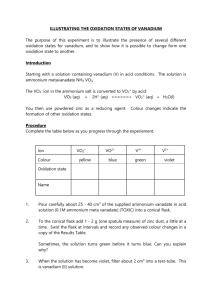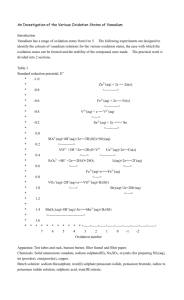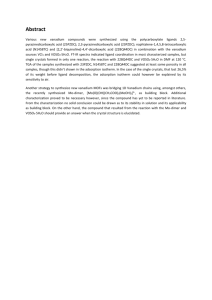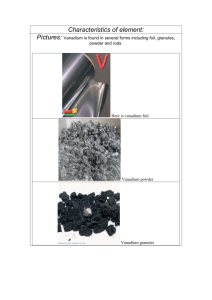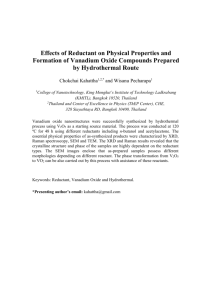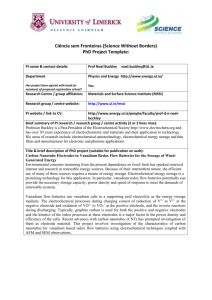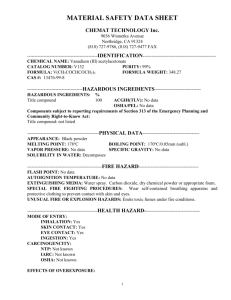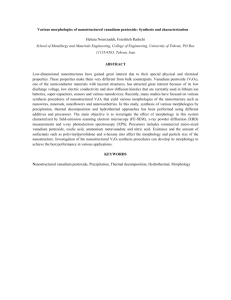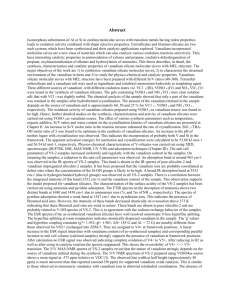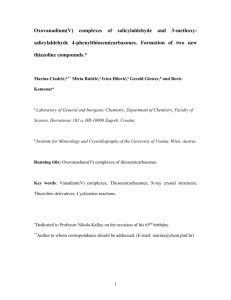Illustrating the oxidation states of vanadium
advertisement
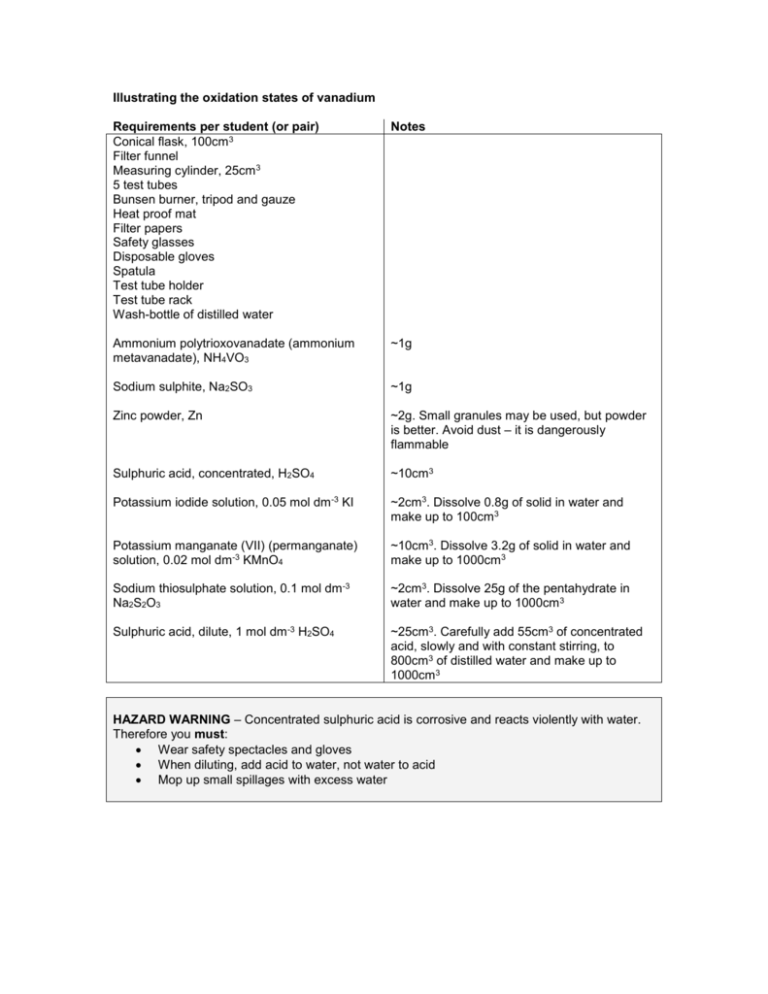
Illustrating the oxidation states of vanadium Requirements per student (or pair) Conical flask, 100cm3 Filter funnel Measuring cylinder, 25cm 3 5 test tubes Bunsen burner, tripod and gauze Heat proof mat Filter papers Safety glasses Disposable gloves Spatula Test tube holder Test tube rack Wash-bottle of distilled water Notes Ammonium polytrioxovanadate (ammonium metavanadate), NH4VO3 ~1g Sodium sulphite, Na2SO3 ~1g Zinc powder, Zn ~2g. Small granules may be used, but powder is better. Avoid dust – it is dangerously flammable Sulphuric acid, concentrated, H2SO4 ~10cm3 Potassium iodide solution, 0.05 mol dm -3 KI ~2cm3. Dissolve 0.8g of solid in water and make up to 100cm3 Potassium manganate (VII) (permanganate) solution, 0.02 mol dm-3 KMnO4 ~10cm3. Dissolve 3.2g of solid in water and make up to 1000cm3 Sodium thiosulphate solution, 0.1 mol dm -3 Na2S2O3 ~2cm3. Dissolve 25g of the pentahydrate in water and make up to 1000cm 3 Sulphuric acid, dilute, 1 mol dm -3 H2SO4 ~25cm3. Carefully add 55cm3 of concentrated acid, slowly and with constant stirring, to 800cm3 of distilled water and make up to 1000cm3 HAZARD WARNING – Concentrated sulphuric acid is corrosive and reacts violently with water. Therefore you must: Wear safety spectacles and gloves When diluting, add acid to water, not water to acid Mop up small spillages with excess water Name: Date: Experiment – Illustrating the oxidation states of vanadium Aim The purpose of this experiment is to illustrate the presence of several different oxidation states for vanadium, and to show how it is possible to change from one oxidation state to another. Introduction Starting with a solution containing vanadium (V) in acid conditions, you use powdered zinc as a reducing agent. Colour changes indicate the formation of other oxidation states. After this first series of reactions you perform some changes between oxidation states by using a variety of oxidising and reducing agents. Assessment and Timing You are not being assessed on this experiment but it will count for 1.5 hours of practical time Requirements Safety glasses Disposable gloves Conical flask, 100cm3 Spatula Ammonium polytioxovanadate(V), NH4VO3 (ammonium metavanadate) Measuring cylinder, 25cm3 Sulphuric acid, dilute, 1 mol dm -3 H2SO4 Sulphuric acid, concentrated, H2SO4 5 test tubes and holder Test tube rack Zinc powder, Zn Bunsen burner, tripod and gauze Heat proof mat Filter funnel and paper Potassium manganate (VII) solution, 0.02 mol dm -3 KMnO4 (permanganate) Sodium sulphite, Na2SO3 Potassium iodide solution, 0.05mol dm -3 KI Sodium thiosulphate solution, 0.1mol dm -3 Na2S2O3 Wash-bottle of distilled water HAZARD WARNING – Concentrated sulphuric acid is corrosive and reacts violently with water. Therefore you must: Wear safety spectacles and gloves When diluting, add acid to water, not water to acid Mop up small spillages with excess water Procedure 1. First complete the table below to assist you in identifying the different oxidation states of vanadium. Ion (hydrated) *VO2+ VO2+ V3+ V2+ Colour Yellow Blue Green Violet Dioxovanadium (V) Oxovandaium (IV) Vanadium (III) Vanadium (II) Oxidation state Name *The VO3- ion in the ammonium salt is converted to VO2+ by acid: VO3-(aq) + 2H+(aq) VO2+(aq) + H2O(l) 2. Place about 0.25g (one spatula measure) of ammonium trioxovanadate (V) in a conical flask and add about 25cm 3 of dilute sulphuric acid. Carefully add about 5cm 3 of concentrated sulphuric acid and swirl the flask until you obtain a clear yellow solution. 3. Pour about 2cm 3 of this vanadium (V) solution into each of two test tubes ready for later tests. 4. To the conical flask add 1 – 2 g (one spatula measure) of zinc powder, a little at a time. Swirl the flask at intervals and record any observed colour changes in the results table. 5. When the solution has become violet (you may need to heat the flask for this final change), filter about 2cm 3 into each of three test tubes. 6. To one of the three tubes, add a little at a time, an excess of acidified potassium manganate (VII) solution, shaking after each addition, until no further change is observed. 7. Keep the other test tubes of solutions for later tests. Answer the first two questions and complete the results table as far as you can before doing further tests. 8. To one of the tubes containing vanadium (V) add a little sodium sulphite and shake. Filter if cloudy. Now boil carefully (in a fume cupboard, if possible) to remove excess sulphur dioxide and add about the same volume of vanadium (II) solution. Record your observations. 9. To the second of the tubes containing vanadium (V), add about 2cm 3 potassium iodide solution and mix. Then add about 2cm 3 of sodium thiosulphate solution. Record your observations. Results Table Test Observations Summary of Reaction Ammonium vanadate + acid White solid turned red and dissolved to a yellow solution VO3- VO2+ +5 +5 Vanadium (V) + zinc Vanadium (II) + manganate (VII) Vanadium (V) + sulphite Add vanadium (II) Vanadium (V) + iodide + thiosulphate Questions 1. How do you explain the first appearance of a green colour in the solution? 2. What are the subsequent changes in colour and why do these changes occur?
